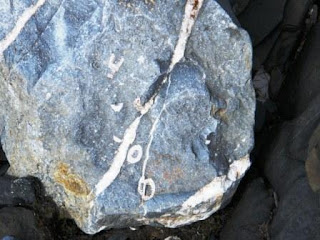 The Grey Mare's Tail
The Grey Mare's Tail
Eight months since I got my new hip, time for some field trials. With no unclimbed Munros near at hand, I settled for a Corbett (2500 to 3000 ft.). After last week’s foray up the Yarrow valley, it seemed natural to venture just a wee bit further over the watershed into Moffatdale to White Coomb. Roadside car parking, courtesy of the National Trust and a well maintained, if fairly steep, path up the side of the Grey Mare’s Tail waterfall was a easy start to the climb. Sun hat, sunscreen, plenty of fluids – gone are the days when you could happily drink from hill burns - a fleece, for despite the sunny day, the temperature at the top might be a lot less, and off I set.
Up the long “staircase” to the top of the falls then further up to Loch Skene sitting in its little valley below Lochcraighead . Itself no mean hill at over two thousand feet. – a so-called Donald after Donald’s lists of lowland hills of this height,- it lowered over the loch.
Halfway up, a hawk cried from a high crag but was too far off to identify, possibly a merlin. I had seen one in a neighbouring valley previously.

 Lochcraighead looms over Loch Skene while a couple of feral goats pay me no attention
Lochcraighead looms over Loch Skene while a couple of feral goats pay me no attention
Lochcraighead proved a bit of a challenge on the old legs but once the summit was reached, the ridge out to White Coomb looked a nice stroll following the county boundary fence. Ah, the county boundary – a face saver, indeed, maybe even a life saver, in the days before GPS navigational aids. Lost in the mist – find the boundary fence and you knew where you were on the map. Follow it and you would get to somewhere else on the map without risk.
 The boundary wall and fence !
The boundary wall and fence !
White Coomb provided the greatest of views. To the east the Eildons and the Lammermuirs: to the north the Pentlands and the southern edge of the Grampians : west to the Manor hills : south to the Cheviots, then over to the Lowthers and, hanging in the haze, the Lakeland fells.
 White Coomb from Loch Skene
White Coomb from Loch Skene
Going up had been strenuous enough but, oh, coming down was hard on the old joints. Plenty of stops gave me time to admire the carpet of wild flowers. Yellow stars of tormentil, the deep blue of milkworts, the tufts of bog cotton, northern orchids, and masses of dwarf cornel. Apparently, its berries are an appetite stimulant which gives it its Gaelic name lus a chraois – plant of gluttony. I would have thought climbing two thousand feet would have been enough of a stimulant without any berries.

Dwarf cornel
Down at car-park level, there was time for an expedition up to Dobb’s Linn to look for fossils. The fossils are easily found amongst the oil shale rocks -Ordivician graptolites, like little doodles on the slatey shale. 
Dobb's Linn
The most pleasing find was the linn itself, a delightful little three-stage fall, much prettier than its big blowsy hyped up neighbour down the road.
So the new pin stood up to a bit of off-roading. Well done, the orthopods !

The blue remembered hills ...............where I went but cannot come again
but now I can, thanks to the skill of the orthopaedic surgeons and the marvels of technology. I am very thankful.
 The Approaching Storm
The Approaching Storm













 Fossils
Fossils









 Interior of mill
Interior of mill
















+of+squirrel.JPG)

 UFO (Unidentified Floral Object)
UFO (Unidentified Floral Object)


